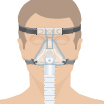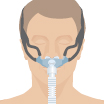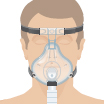Customer Service and Live Chat available M-F from 8:30AM - 4:30PM EST
Finding The Right Mask
Finding the Right Mask and Fit
All PAP therapy masks are worn on the face and provide a gentle stream of air through your nose and/or mouth. The mask should be comfortable, fit securely (but not tightly), and leave no red marks. Also, the correct mask will allow you to sleep in your normal position regardless of whether it is back, side or stomach. Having a comfortable mask is a key factor in being able to use your treatment daily. Without daily use, the symptoms of OSA are likely to reappear, so it's very important to find a mask that fits you and your lifestyle.
There are so many types of masks, you're likely to find more than one that's right for you. Most masks fall into three categories:
- Nasal masks
- Nasal pillow masks
- Full face masks
Learn more about the three most common types of masks in the chart below.
- Nasal
 Seals over your nose; shaped like a triangle; attaches with four-point headgear; oldest and most popular type of CPAP mask
Seals over your nose; shaped like a triangle; attaches with four-point headgear; oldest and most popular type of CPAP mask - Nasal Pillow
 Seals around the base of your nostrils; shaped like two small, soft pillows; attaches with headgear; makes minimal contact with your face; lightweight
Seals around the base of your nostrils; shaped like two small, soft pillows; attaches with headgear; makes minimal contact with your face; lightweight - Full Face
 Seals around your nose and mouth; shaped like a triangle; attaches with four-point headgear; offers even support; ideal for people who sleep with their mouth open
Seals around your nose and mouth; shaped like a triangle; attaches with four-point headgear; offers even support; ideal for people who sleep with their mouth open - Recommended if you...
- Breathe through your nose



- Breathe through your mouth

- Sleep on your side


- Use high pressure

- Have facial hair


- Have sensitive skin

- Wear glasses

- Wear dentures

- Watch TV or read in bed

- Want a lightweight mask

- Have difficulty getting a good seal

Some PAP devices have a mask leak check feature to see if your mask is tight enough. Ask us if this is an option for you to better understand how your mask may be checked for leaks prior to going to sleep.
Talk to us about the different types of masks available. If you can, try on several masks to compare fit and comfort. It might take a few tries before you find the mask that's right for you. But it's important to stick with your therapy during this process.
